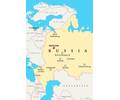Arctic Sea Ice Decline
By Aiswarya Lakshmi
May 25, 2015
Sea ice in the Arctic Ocean is at its lowest May level since records began in the 1980s, says Al Jazeera.
The lowest levels in the history of Arctic sea ice observation for this time of year and likely the lowest levels for hundreds, even thousands of years.
The problem is not just one of a new record low. It’s one of timing and divergence. Accelerated melt in the May-to-June time-frame can have serious impacts on late season ice.
The reason is that greatly reduced ice coverage also reduces albedo or reflectivity. The result can be compounded warming and increased heat absorption by darker surfaces under the 24 hour Arctic sunlight of June and July.
When compared with a 30 year average of 12.5m sq km, the current ice coverage around the North Pole is just 11.32m sq km.
The report says that this figure is even lower than the 11.89m sq km of 2012, when sea ice coverage reached its lowest summer time level. Ice extent generally reaches its lowest level in mid-September. In 2012 there was just 3.2m sq km of sea ice in the Arctic.
According to the Intergovernmental Panel on Climate Change (IPCC) Arctic sea ice decreased at a rate of around four percent per decade between 1978 and 1996.
The IPCC expects the extent of sea ice to decrease by 20 percent by 2050, with some ice-free summers by the same time.
Scientists have measured the rate of thinning of the great sea ice shelf of the Antarctic Peninsula and have identified the mechanisms at work above and below the shelf.
The collapse of floating sea ice makes no direct difference to global sea levels – but the effects could nevertheless lead to higher waters everywhere.
University of Washington researchers compiled modern and historic measurements to get a full picture of how Arctic sea ice thickness has changed.
The results show a thinning in the central Arctic Ocean of 65 percent between 1975 and 2012. September ice thickness, when the ice cover is at a minimum, is 85 percent thinner for the same 37-year stretch.
Previously inaccessible shipping routes will become open to commercial traffic as ice continues to melt.



